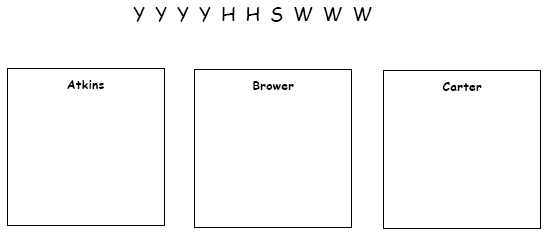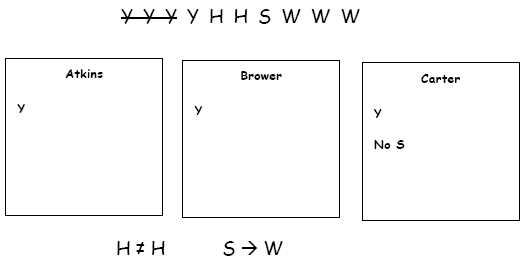LSAT Grouping Sketches
Let’s take a look at some common techniques for sketching LSAT logic games. This is the second article in a series of articles about LSAT logic games. The series includes:
- LSAT Grouping Games: an introduction
- LSAT Grouping Sketches
- LSAT Grouping Questions
LSAT Grouping Sketches
There are two basic approaches to sketching grouping games. One is to make vertical columns for each group, another is to make boxes. TestSherpa makes boxes so that it’s easy to differentiate a grouping sketch from a matching sketch if you have extra time and return to a game during the test. If you prefer columns that’s fine, just make sure you do your sketches the same way every time you practice so that it’s second nature come test day.
Here is the set up from the grouping game from the last article:
A clerk at a hardware store has to sort ten items into three boxed customer orders—Atkins, Brower, and Carter. The items are four yardsticks, two hammers, one screwdriver, and three wrenches.
Each customer ordered at least one yardstick
No customer ordered more than one hammer
The customer who ordered the screwdriver ordered at least on wrench
Carter did not order the screwdriver
First of all, you know you’ve got a grouping game of the sorting variety because you’re going to put all of the items into boxes. So draw the boxes and make a list of the items. Don’t just write “4Y” to indicate four yardsticks—remember we’re sorting so we want to see a complete list. Actually write “Y Y Y Y” so that you can see how many you have and cross off the ones you’ve already used.
Your sketch might look like this:

Paraphrase the Rules
Now that you have your sketch ready, make a paraphrase of the rules. The best rules are the ones you can add directly to your sketch, but if you can’t do that, at least make a paraphrase that you can instantly recognize rather than rereading the stimulus.
Here are the rules again, with suggestions for how to paraphrase them:
Each customer ordered at least one yardstick; Paraphrase: Add a “Y” to each box and cross of three Y’s on your list.
No customer ordered more than one hammer; Paraphrase: H ≠ H (meaning they can’t share the same box)
The customer who ordered the screwdriver ordered at least on wrench; Paraphrase: S –> W (meaning, if screwdriver, then wrench). Think of these as always going together as a pair, a two-for-one.
Carter did not order the screwdriver; Paraphrase: Write “no S” in Carter’s box.
Your sketch should now look something like this:

Make Deductions
Now it’s time to get the extra bonus points out of the game. Remember our discussion of the contra-positive in the formal logic lesson? Here’s another place it comes into play.
The screwdriver rule, “S –> W” means if S, then W. By taking the contra-positive (flip the terms and negate them), you come up with an extra rule that the non-TestSherpa students don’t have: if not W –> not S. Add that to your sketch.
Do not make the error of denying the antecedent. Just because no screwdriver exists in a box doesn’t mean no wrench exists in that box. Also, do not make the error of affirming the consequent—the presence of a wrench does not conclude the presence of a screwdriver.
That’s the big deduction. Since this is a game of sorting, expect several hypothetical questions that deal with limiting which items go where and how many can fit inside a box.
Now let’s tackle the entire game and see how to handle LSAT grouping questions.
